Question: A classroom teacher wants you as a teacher-librarian to participate in a more traditional research process as an initial foray into the use of the SLLC, and inquiry practices. Discuss what you would do, and why.
The first thing, in my opinion, that the teacher-librarian should do when a classroom teacher initiates collaboration is to demonstrate a positive attitude. The teacher-librarian should nurture the working relationship and show appreciation for the teacher’s desire to collaborate. The teacher-librarian must make the teacher feel supported and be open to their ideas. It is also important that the teacher-librarian show flexibility with what the teachers want to achieve and their busy schedule. The teacher-librarian must learn what the teacher’s goals are for the activity and adapt services to the teacher’s and student’s needs. The teacher-librarian must aim for true collaboration to build trust. The teacher-librarian will think of ways to enhance and improve the teacher’s efforts without overstepping or changing the vision that the teacher may have for a certain inquiry. Stripling says, “librarians must decide how to enhance the teacher’s instruction and impact learning without disrupting the teacher’s preferred teaching style”. (Stripling 2012)
The following Piktochart demonstrates what true collaboration looks like.
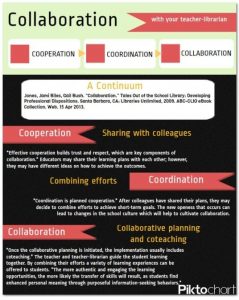
The purpose of the teacher-librarian is to lead the teachers to pursue inquiry investigations with their students. Teacher-librarians must adapt their services for teachers and offer to combine efforts to achieve the goals set out by the teacher. Stripling states in her article entitled Inquiry through the eyes of Classroom Teachers that:
“Librarians can encourage teachers to provide opportunities for students to pursue inquiry investigations, but they must also meet teachers and students where they are and develop new strategies to enhance their teaching and learning in the classroom.” (Stripling, 2012)
The next step would be to find out everything about what the teacher wants to achieve. The teacher may want the students to learn about the SLLC (School Library Learning Common) and the services it can provide. The teacher may want the students to learn the skills to do efficient research, how to formulate higher thinking inquiry questions, how to compare websites and information, how to write a bibliography, do note-taking skills, or simply how to use the school library system to find books related to various topics. The teacher-librarian can offer to meet with the teacher at their preferred time to discuss the goals and reason for the visit to the SLLC. This offers the teacher-librarian the opportunity to make subtle changes to the teaching process through planned cooperation. If indeed the teacher is looking for help with the acquisition of inquiry skills, then the teacher-librarian has many options to help the teacher.
- The “embedded librarian” strategy. The teacher-librarian visits the classroom prepared with activities that will teach the students the framework of the inquiry process.
- The teacher-librarian and classroom teacher can collaborate to target specific skills to integrate into a series of mini inquiry lessons.
- The teacher-librarian can prepare a plan for the teachers to follow to teach inquiry skills in the classroom and include graphic organizers.
- The teacher-librarian can introduce additional specialized resources such as maps, photos, online databases) to the teacher can use them when teaching inquiry skills.
- The teacher-librarian can facilitate professional development. (Stripling, 2012)
In Fontichiaro and Oehrli’s 2014 article about collaboration, they state that: “As a librarian, if you don’t show the impact, it’s not going to be worth it. The teacher has enough going on.” The teacher-librarian must show the teacher that their help will have an impact on the students. Teachers are very busy, and it is important for them to see the big picture and what kind of impact the teacher-librarian’s help will have.
Question 2: Identify and discuss some strategies or structures that you could use in the classroom or SLLC to foster enjoyment of learning.
Most children are eager to explore and learn new things. Babies and children are naturally curious and seek to learn about the world around them. Our students will have the same curiosity and desire to learn when they are part of a thriving learning environment.
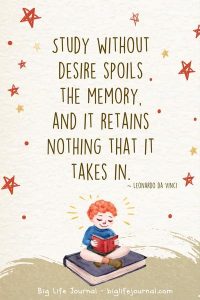 Image by biglifejournal.com
Image by biglifejournal.com
An enjoyment of learning and a thriving learning environment can be developed and cultivated by using a variety of strategies and structures in the SLLC and in the classroom. The strategies used to foster an enjoyment of learning lead to the development of core competencies. Students develop an inquiry mindset which leads to successful inquiry experiences.
“If you can light the spark of curiosity in a child, they will learn without any further assistance. Children are natural learners… Curiosity is the engine of achievement (Robertson, TED 2013)
Strategies and Structures for developing an enjoyment of learning and a thriving learning environment:
- Respect, support, and encouragement:
Teachers should always strive to build positive relationships with their students. Teachers are role models for respect and the student learn directly from their example. Respect and trust between students and teachers allow for the learning environment to thrive. Students can openly explore and discover without judgment. Respect is part of the foundation of learning. When trust is established, students will better relate to their teachers. Teachers need to build a foundation of trust where students feel that the teacher’s support and encouragement are genuine.
“We trust their (the student) judgment and we respect their opinions. This feeling of trust opens the door to new possibilities. It is an environment that students thrive in, a space where they can be free to create, explore, wonder without judgment.” (Harper, O’Brien, 2012, p.11)
Understanding your student will help to build a positive environment for learning in the classroom or SLLC. This will allow the teacher to pinpoint the needs of the students, how they learn best, what they are interested in, and what the teacher must do to appeal to the students.
With the knowledge of what the student’s interests and abilities are, the teacher can provide high-interest learning experiences that empower the student to learn new things, to questions, and motivate themselves.
“Truly knowing our students, their interests, and strengths, helps create a classroom of learners. We foster what they can do and empower them to extend themselves to learn new things.” (Harper, O’Brien, 2012, p.10)
- Teachers are learners too:
To develop an enjoyment of learning, the teacher must show that they are learners too and that they truly enjoy learning. When the teacher demonstrates that they are learning, they model risk-taking, passion for learning, vulnerability, curiosity, and perseverance. This will incite the students with the desire to learn by sharing experiences of working through the learning process. This will show the students that the focus is on learning.
“ Because if you enjoy your teaching, it is going to help the children tremendously. Enjoying teaching has two components, First, enjoying the subject matter and pushing the subject matter for its own sake. The other component is to enjoy interacting with children and seeing them learn. (as cited in UBC, module 3, The Inquiry Mindset, 2021)
- Motivating and engaging learners:
Teachers use strategies to motivate their students. The goal is to motivate them to practice higher-level critical thinking skills and promote meaningful learning experiences. Csikszentmihalyi states that learning matters to those who are involved. Meaningful learning experiences can motivate and encourage the students to get involved. He talks about “flow” as:
“The experience we have when we’re “in the zone”. During a flow state, people are fully absorbed and highly focused, they lose themselves in the activity.” (O’Keefe, P. A. 2014)
The following diagram demonstrates the various aspects needed to boost student engagement using the “Flow Theory”.
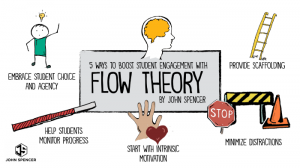
Image by medium.com
- Encourage creativity:
To encourage creativity the teacher can provide learning opportunities where students to have discussions and ask questions. Harper and O’Brien state in their article entitled How to put Students in the Driver’s Seat that:
“The most important motivators to learning are intrinsic passion and an interest in the work itself.” ((Harper, O’Brien, 2012, p.11)
Teachers must choose topics that the students can relate to and that are engaging and meaningful. The teacher strives to help the student discover what interests them, pursue areas of self-interest, and to encourage divergent thinking. A topic is only interesting to the student if it is personally valuable to them.
“Look beyond the curriculum and home in on student interests… we are as actively engaged in the learning process as the students and act to provide support and direction through hands-on, minds-on learning experiences.” (Harper, O’Brien, 2012, p.10)
- Allow the students to work collaboratively:
Allowing students to work collaboratively allows them to take responsibility for their own learning. To foster an enjoyment of learning the teacher must trust the student to make their own decisions.
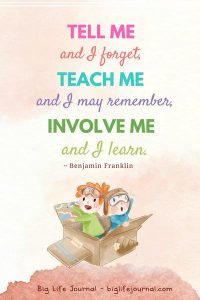 Image by biglifejournal.com
Image by biglifejournal.com
Learning opportunities should be structured allowing the student to make choices. This will give them a sense of ownership. This will encourage the student to make deeper connections and bring more meaning to their learning.
“Students feel empowerment when they can pick their own topic and they will research it with eagerness…” (Harper, O’Brien, 2012, p.10)
- The Zones of Regulation
Teaching the students how to use Zones of Regulation will help them acquire the skills to control and adjust emotions and behavior around changing tasks. If the students are taught to use the steps of the Zones of Regulation, they will more easily self-regulate their feelings, assess their level of comfort, use strategies to cope with challenging academic tasks, set goals, and manage social interactions. This will enhance the learning environment.
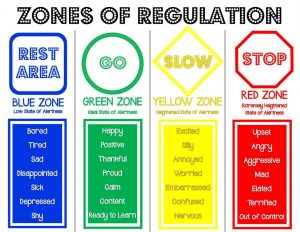
Image by http://www.wsr-tlc.com/
Bibliography
“Collaboration and Inquiry.” Saskatchewan School Library Association, www.ssla.ca/collaboration-and-inquiry.html
Rheingold, Howard. “The New Power of Collaboration.” TED, www.ted.com/talks/howard_rheingold_the_new_power_of_collaboration?language=en
Spencer, John. “Five Ways to Boost Student Engagement with Flow Theory.” Medium, The Synapse, 12 Apr. 2020, www.medium.com/synapse/five-ways-to-boost-student-engagement-with-flow-theory-ea68064be708
“Learning Commons in Action.” Canadian School Libraries, www.canadianschoollibraries.ca/learning-commons-in-action/
Biglifejournal.com. “7 Ways to Instill A Love of Learning in Children.” Big Life Journal, www.biglifejournal.com/blogs/blog/instill-love-learning-children
Raffaelli, Lina. “32 Strategies for Building a Positive Learning Environment.” Edutopia, George Lucas Educational Foundation, 3 Sept. 2014, www.edutopia.org/discussion/32-strategies-building-positive-learning-environment
Harper, Jennifer and O’Brien, Kathryn. (2012). How to put students in the driver’s seatLinks to an external site.. In Student-Driven Learning: Small, medium and big steps to engage and empower students (pp. 9-14). Markham, ON: Pembroke Publishers.
https://www.shiftelearning.com/blog/why-you-should-spend-more-time-with-your-learners
Maloney, D. H. (2010). Solving problems that countLinks to an external site.. Educational Leadership 68(1): 55-58.
Moreillon, J., Luhtala, M. & Russo, C. T. (2001). Learning that sticks: Engaged educators + engaged learnersLinks to an external site.. School Library Monthly 28(1): 17-20.
O’Keefe, P. A. (2014, Sept. 12). Liking work really matters (Links to an external site.). The New York Times, p. 12.
Fontichiaro, K. & Oehrli, J. A. (2014a). Nudging toward inquiry – Turning the tables on collaboration part I: Planning for successLinks to an external site.. Library Media Connection 32(4): 36-38.
Fontichiaro, K. & Oehrli, J. A. (2014b). Nudging toward inquiry – Turning the tables on collaboration part 2: Reflecting on successLinks to an external site.. Library Media Connection 32(5): 34-35.
Hamilton, B. J. (2011a). Creating conversations for learning: School libraries as sites of participatory cultureLinks to an external site.. School Library Monthly 27(8): 41-43.
Marcoux, B. L. (2007). Levels of collaboration: Where does your work fit in?Links to an external site. School Library Activities Monthly 24(4): 20-24.
Stripling, B. K. (2012a). Inquiry through the eyes of classroom teachersLinks to an external site.. School Library Monthly, 28(8), 18–20.
